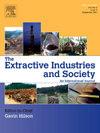印度喀拉拉邦河砂开采与生物多样性保护的难题
IF 3.6
2区 社会学
Q2 ENVIRONMENTAL STUDIES
Extractive Industries and Society-An International Journal
Pub Date : 2025-04-17
DOI:10.1016/j.exis.2025.101671
引用次数: 0
摘要
许多研究表明,不加控制的采砂会造成严重的环境后果。意识到这些不利影响,印度喀拉拉邦政府对河砂开采进行了监管。该州的建筑行业是开采砂的最大消费者,其反应是用人造砂(m砂)取代河砂,人造砂是通过粉碎从该州中部和山区开采的石头而获得的。为了评估采砂禁令对西高止山脉生物多样性的影响,对保护区10公里缓冲区内72个采石场的面积扩张进行了分析。利用GIS和谷歌Earth Pro的历史图像工具,我们将采石场在禁令实施前三年的平均年扩张与禁令全面实施的2016年的扩张进行了比较。2016年的扩张是过去十年平均年增长的1.74倍,一些采石场的面积增加了一倍多。与世界其他地区的研究比较表明,采石活动的增加会显著影响西高止山脉的生物多样性。该研究强调了在制定环境政策和法规方面采取更全面和综合的方法的重要性,以防止产生适得其反的结果。本文章由计算机程序翻译,如有差异,请以英文原文为准。
The conundrum of river sand mining and biodiversity conservation in Kerala, India
Many studies have shown that uncontrolled sand mining can have severe environmental consequences. Realizing these adverse impacts, the government of Kerala, India, regulated river sand mining. The construction industry in the state, the largest consumer of the mined sand, reacted by replacing river sand by manufactured sand (M-sand), which is obtained by crushing the stones quarried from the midlands and high ranges of the state. To assess the impact of sand mining ban on the biodiversity of Western Ghats, the areal expansion of 72 quarries within a 10 km buffer of protected areas was analysed. Using GIS and Google Earth Pro's Historical Imagery tool, we compared the quarries' average annual expansion over the three years preceding the ban with their expansion in 2016, the year the ban was fully enforced. The expansion in 2016 was 1.74 times the average annual increase over the decade, with some quarries more than doubling in area. A comparison with studies from other parts of the world suggests that increased quarrying can significantly affect the biodiversity of the Western Ghats. The study highlights the importance of more holistic and integrated approaches to formulating environmental policies and regulations, to prevent counterproductive outcomes.
求助全文
通过发布文献求助,成功后即可免费获取论文全文。
去求助
来源期刊

Extractive Industries and Society-An International Journal
ENVIRONMENTAL STUDIES-
CiteScore
6.60
自引率
19.40%
发文量
135
 求助内容:
求助内容: 应助结果提醒方式:
应助结果提醒方式:


